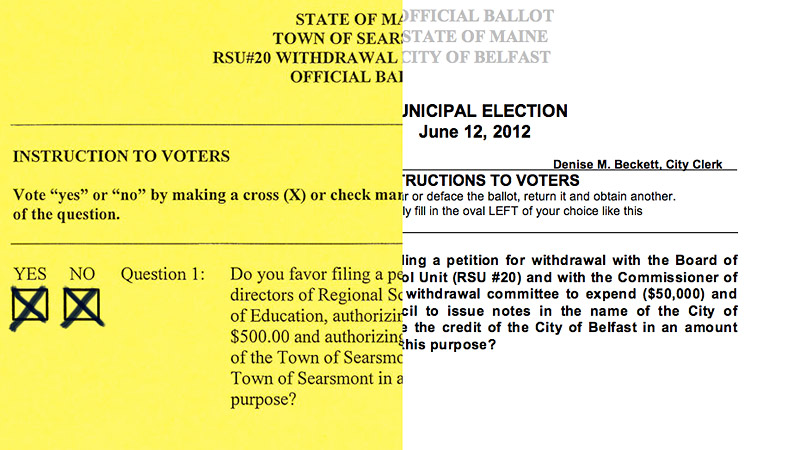What did we vote on, again?

SEARSPORT – Voters in Belfast, Belmont, Morrill, Northport, Searsmont and Swanville have approved pursuing withdrawal from Regional School Unit 20. But have they voted to withdraw or simply to weigh the options?
Belfast petitioners who started the movement to secede from the nine-town district that stretches from Northport to Frankfort are envisioning a return to the six-town School Administrative District 34, which was merged in 2009 under a statewide consolidation law with neighboring SAD 56.
But others may have thought they voted for something akin to a feasibility study.
Eric Sanders, Belfast city councilor and member of the city’s four-person RSU 20 Withdrawal Committee, told the RSU 20 board of directors on Tuesday night that Belfast is within a week-and-a-half of presenting a plan, or possibly multiple plans from the six towns, to the board.
The news seemed to surprise some school board members, who thought the process would unfold differently.
Sanders, likewise, said he was surprised there were so many questions about the committee’s work. The referendum approved in the six towns was based on statutory language from the state. Its intent, he felt, was crystal clear.
So what exactly did voters agree to?
The question as it appeared to Belfast voters on June 12, read:
Do you favor filing a petition for withdrawal with the Board of Directors of Regional School Unit (RSU #20) and with the Commissioner of Education, authorizing the withdrawal committee to expend ($50,000) and authorizing the City Council to issue notes in the name of the City of Belfast or otherwise pledge the credit of the City of Belfast in an amount not to exceed ($50,000) for this purpose?
While state law requires a second vote to finalize a town’s withdrawal from a school district, Sanders said the approval of the ballot question amounted to a vote to withdraw. What remained, he said, was to create a viable plan that voters could accept or reject at a final referendum.
The withdrawal effort may hit other snags. State law only addresses single towns leaving a district and makes no mention of former districts being decoupled from a consolidated district.
But several board members said the June vote could have been interpreted as authorizing an study of the effect of leaving the district.
“I was very much for it,” said Belfast representative Orya Shomron, “but I learned afterward … if you look carefully at the language, that I’d voted for withdrawal.”
Board member Dorothy Odell, also of Belfast, said Wednesday that the wording of second half of the question may have led some voters to a more ambiguous interpretation of the otherwise clear message.
“I’ve talked to a number of people who had the same [interpretation], who when they voted, said, ‘I’m open to this. Let’s explore it.’”
The basic language of the question as it appeared on ballots in the other five towns was identical to Belfast’s — initial results from Swanville were voided by the state for deviating from the statutory language; the town is scheduled to re-vote on Oct. 2.
The dollar amounts set aside for the petitioning effort, however, were substantially smaller outside of Belfast — Searsmont, for example, allotted $500 to the effort.
Steve Hutchings, a teacher at Belfast Area High School who led the initial petition drive to bring the question to a vote and currently serves on the city’s withdrawal committee, said he advised the surrounding towns to take a back seat rather than duplicate Belfast’s efforts.
Conversations with officials in Searsmont and Morrill indicated those towns were waiting for Belfast to come up with a plan.
For board member Debora Riley of Northport, the idea of Belfast leading the way to a new SAD 34 brought back memories of the old SAD 34 when, she said, the city exerted control over the smaller towns. Riley made an appeal for Northport to have representation on the committee that ultimately negotiates with RSU 20.
Belfast representative Alan Wood said the Belfast Withdrawal Committee should be careful to be accurate in its presentation of information, noting that fear of school closings may be motivating some people to want to withdraw from the RSU.
Sanders countered that his committee was simply doing the job that voters approved in June.
“There is no plan to consolidate schools or close schools at this time,” said RSU 20 Superintendent Brian Carpenter after Sanders’ presentation. Carpenter added that the district is “looking outside the box” with regard to potential savings.
A Frankfort resident attending Tuesday night’s meeting likened the withdrawal process his town is currently undertaking in hopes of joining with the Hamden school district to “a divorce.” Though the former SAD 34 towns would not be trying to join another district, the separation process would be the same, meaning: awkward.
A municipality that votes to pursue withdrawal must create a committee that includes among its four members a school board representative from the district the town hopes to leave.
Four of the six towns that are considering withdrawal from RSU 20 have just one representative on the school board. By default, that person continues to work for the district while also ostensibly plotting to secede from it.
Despite holding six seats on the RSU 20 board, Belfast’s appointee said she agreed to serve because “no one else would do it.”
Odell said she was personally against the consolidation in 2009 out of concern for loss of local control, but since then she’s seen benefits to the consolidated district, including shared administrative costs and a provision under which a student could get a waiver to attend a different school within the district.
“Now that it’s been in place for a while, I very much think we should stick with the devil we know,” she said, “because there are always unintended consequences when you change.”
Odell described feeling an “emotional conflict of interest” serving both the board and the withdrawal effort.
The withdrawal effort may hit other snags. State law only addresses single towns leaving a district and makes no mention of former districts being decoupled from a consolidated district.
For this reason, the six towns of the former SAD 34 have had to vote, create committees and ostensibly pursue withdrawal independently.
They have. But from the outset the efforts have been coordinated to varying degrees, and Belfast, where voters approved spending up to $50,000 to create a withdrawal plan, has been the engine.
After Tuesday night’s meeting, Sanders said he was surprised by the board’s reaction to his report, but said the Belfast committee will continue its work.
“I think the realization hit them that we’re ready and waiting and all the towns and communities have voted for a withdrawal plan.
Sanders said he understands that the board may be frustrated by the threat of a mass secession from the district.
“But they need to let us do our job for the voters,” he said.
Penobscot Bay Pilot reporter Ethan Andrews can be reached at ethanandrews@penbaypilot.com





























